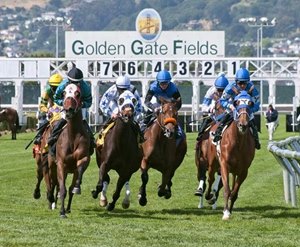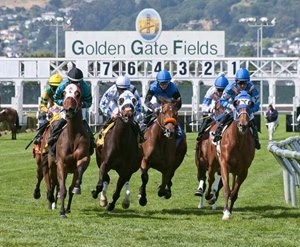Golden Gate Fields Finding Its Niche to Grow Purses


The landscape surrounding California racetracks fighting to grow their product is far from fertile.
Tracks across the country have access to a myriad of revenue streams from slot machines, historical racing games, card rooms, and sports betting, but the Golden State ovals can only grow their businesses and purses by increasing handle through on-track and simulcast wagering.
Among United States racetracks running 50 days of live racing or more in 2018, the top 15 by percent growth in average daily purses include only two racetracks that do not have access to alternative gaming revenue—Arlington International Racecourse and Golden Gate Fields.
Arlington got a bump from $1.6 million approved by the state legislature for owners' awards and stakes races. The track also had an underpayment in its 2017 purse account.
Golden Gate Fields did not get any money from its legislators, instead the San Francisco area track has been steadily carving out a niche in the simulcast market that grew its out-of-state handle 37% and its overall handle 16.8% compared with 2017, according to statistics published by the California Horse Racing Board. The higher handle has allowed Golden Gate to increase its average daily purse 7.9% to $152,590.
Higher purses have helped improve field size, which rose to 6.93 average starters per day from 6.74 in 2017. And, of course, those larger field sizes attract increased betting interest.
Patrick Mackey, Golden Gates' racing secretary, credits the growth to a variety of factors, including diligently watching the timing of its races with others in the simulcast market and to a commitment by management to run nothing shorter than a six-horse field.
"When David Duggan, our vice president and general manager, came to town, he kept an eye on finding the right spots for our races and worked to find our niche on the simulcast map," Mackey said. "We have a small but effective team that works out a game plan at the beginning of each day. We stick to it, but it also depends on what other tracks do. We have to zig and zag at the right time and last year it worked out."
The scheduling changes Golden Gate has been experimenting with include starting earlier in the day to take advantage of East Coast bettors and scheduling its larger-field races in the middle of the card instead of toward the end.
Golden Gate purses also improved after shutting down the stabling area at Pleasanton. The fair track had been used for years to stable horses running at Golden Gate but gradually became a spot where most of the horses there were yearlings being broken and 2-year-olds in training. A declining number of Pleasanton horses were being shipped to run at Golden Gate, which was paying about $7,900 per day to keep the barn area open. Money for the Pleasanton stabling was coming out of money for purses and from commissions. In 2018, Golden Gate saw the full impact of the money spent previously on Pleasanton going back to its purses.
Several other factors are helping Golden Gate offer a more appealing product, according to Mackey. The track raised its participation fee to $300 from $225, so owners can at minimum cover their expenses to run. The fee increase, coupled with higher purses, is attracting more horses from a broader base of trainers, which is adding value to the betting product.
"We're starting to change the psyche of the trainers with the purse money going up. When I first got here almost five years ago—and I've talked to a lot of people about this—bettors were just turning the page when they saw Golden Gate. It was Jerry (Hollendorfer) and Russell (Baze) winning at 3-5 in almost every race," Mackey said. "Now we've built up some momentum in the simulcast world. I like to think if someone is lucky to cash in a race here, they'll be back.
"When our horsemen enter, they run," Mackey continued. "We rarely get hit with a lot of scratches. Even when it comes off the grass, we have the synthetic track here and people like it. I know some synthetics across the country people are not huge fans of, but this one people like."
Mackey said the track will continue experimenting in every way possible.
"We are looking at where sports wagering is going to go, and California appears to be taking a wait-and-see attitude," he said. "Hopefully that can help us out here because the Indians control the casinos, so we are trying to go solely on handle. We hope to just keep building on it."
